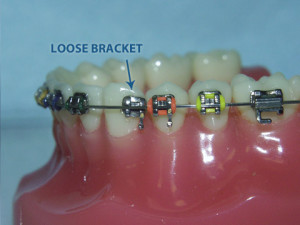Brackets are one of the most important elements of orthodontic braces. To put it simply, they are what holds the wire in place on your teeth. They can be different sizes, colors and shapes depending on the technique used to straighten your teeth. Some examples of different types of brackets include metal twin brackets, self-litigating brackets and clear, ceramic or cosmetic brackets.
Over the course of history, brackets have been made out of many different types of materials. Today, brackets must be hygienic, nontoxic and resistant to corrosion. They must be able to resist forces applied to them by the wire. They cannot absorb water or be discolored by oral liquids such as coffee and they need to have minimal bracket-wire friction.
Most brackets currently used are made out of stainless steel or a stainless steel and titanium combination and are used in the traditional metal-wired method of braces. Ceramic brackets are used as an alternative to metal braces for a more esthetic look. For some, clear removable aligners such as Invisalign, can eliminate brackets all together from the orthodontic straightening process.
Brackets help make up the foundation of braces and are important to pay attention to. A loose bracket can cause discomfort and interruption of your treatment, so make sure to notify your orthodontist immediately if you feel your brackets loosen.

It can be extremely frustrating to have a loose bracket after getting your braces put on. So what causes brackets to come loose? There are a few different reasons to be considered when trying to diagnose bracket failure.
1) Tooth Composition: Brackets need to bond to something when they are being installed. Ideal bond strength is achieved with normal ivory colored enamel. When a bracket is attached to any other surface besides normal enamel, there is a loss of bond strength that results in more frequent debonding. If the tooth has hyper-calcified enamel (white, chalky appearance), hypo-calcified enamel (yellow or brown staining), or any number of dental restorations (filings) is can compromise the bond strength.
2) Bad Bite: If a tooth hits on a bracket when the patient bites down, it is more likely that bracket may become dislodged during chewing. At Tanner & Reichhold Orthodontics, we have our patients bite together after placing brackets to see if any are in occlusion. If they are biting against any of the lower brackets, we bond a composite material on the lower first molars to keep them from hitting.
3) The Patient: Although patients receive clear instructions about what they can and cannot eat with their braces on, changing one’s eating habits can be a big problem. Sticky, hard or sharp foods can dislodge brackets. Habits (such as chewing on pens or biting nails) can also pose a problem. Some patients forget the foods that are on the “No-No List” or can’t break a habit. If a bracket comes loose, contact your orthodontist immediately.
By Dr. Gary Reichhold











